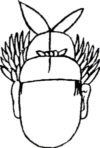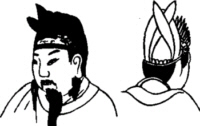Chapter 20 Chapter Five Costumes of Tang and Five Dynasties
There are many kinds of costumes for the emperors of the Tang Dynasty, including 14 kinds such as Daqiu Mian, Dagon Mian, Tongtian Crown, Yishan Crown, Wu Bian, and Bai Ke.Daqiu Mian is the top hat and dress that the emperor wears when offering sacrifices to heaven and earth.The top hat is black on the outside and light red on the inside. The tassel is made of silk, and the yellow cotton hanging on both sides of the hat faces the ears.The dress is made of silk fabric, trimmed with black lambskin, the inside is light red, and the collar and cuffs are black.Red socks and red boats.Wearing a Lulu sword on his body and wearing a pair of white jade.Dagonmian is the attire worn by the emperor when he enthroned, offered sacrifices to temples, confiscated, dispatched generals, received empresses, was congratulated on the first day of the Yuan Dynasty, and worshiped princes in Linxuan.The top hat in the crown of Dagon has 12 white beads hanging down, and the big red silk belt is tasseled.The upper garment is dark blue, the lower garment is bright red, embroidered with 12 chapter patterns.Tongtian crown (shaped like a cirrus cloud, also known as a cirrus crown) is the first garment of the emperor's suburban sacrifices, court congratulations, and banquets. It is better than the previous Tongtian crown. It has 24 beams, 12 cicadas, and pearls. Ornaments), with a black Jieke to carry the crown.Use jade and rhinoceros hairpins to guide.In the eighth year of Zhenguan (634 A.D.), Emperor Taizong of Tang Dynasty began to wear the Yishan crown.Yishanguan got its name because the crown tassel looks like the word "good".During the Yuan Day, Winter Solstice, Shuo, and Wangshi Dynasties, the emperor wore a winged crown and a white skirt.When teaching martial arts, going out on expeditions, and hunting, wear Wubian.When a minister dies, he wears a white gauze jacket and black leather shoes.
The empress wears long-sleeved clothes when receiving books, assistant sacrifices, and court meetings. The pattern of clothing is Hui [hui gray] pheasant (multicolored pheasant); in the spring of the season, she wears bow clothes when she bows to silkworms; undressed.Simplify the six clothes of the queens of the Zhou Dynasty to three clothes.

Yishanguan
The Crown Prince wears the Dagon crown when visiting the temple and accepting concubines; when returning to the palace, Yuanri, and Shuori enter the court, he wears the Yuanyou Crown (shaped like a crown that reaches the sky, with a stretching tube horizontally in front); He wears official uniforms; he wears a black gauze hat when attending events and meeting guests at banquets; ("New Book of Tang·Car Clothes")
There are as many as 20 kinds of costumes for officials in the Tang Dynasty.The official uniform of the first rank is Dagon Mian.The crown has nine pins, and the green pins fill the ears.Tsing Yi clothes, embroidered with nine kinds of patterns, red socks and red gowns, gold and jade decorations, swords and darts.The official uniform of the second rank is the crown.There are eight crowns, blue clothes and tunics, embroidered with seven patterns, red socks and red shoes, and silver swords.The official uniform of the third rank is Wu Mian.The crown has seven pins, the clothes are embroidered with five patterns, the red socks are red, and the golden sword is worn.The official uniform of the fourth rank is the imperial crown.The crown has six handles, the clothes are embroidered with three kinds of patterns, the red socks are red, and the golden sword is worn.The fifth-rank official uniform is Xuanmian.There are five crowns and green clothes.To sum up, it is not difficult to see that the higher the official position, the more crowns, the more complex the clothes, and the better the quality of the sword.
The round-neck robes usually worn by officials in the Tang Dynasty are usually made of fine linen with dark patterns. The collar, sleeves, and skirts are edged. .It is said that this horizontal line was suggested by Ma Zhou, the secretary of the Tang Dynasty, to show that the ancestral system of upper garments and lower garments should not be forgotten.A new type of clothing was popular in Wu Zetian, that is, different patterns were embroidered on the robes of officials of different ranks.Civilian robes embroidered with birds are quite elegant, while military officers' robes are embroidered with animals, showing a brave spirit.This may be the origin of supplementary clothing in the Ming Dynasty.Low-level officials in the Tang Dynasty often wore green robes, also known as green shirts.Du Fu's poem: "The poorest courtiers in green robes will return on foot with their white heads." ("Returning on foot") Bai Juyi's poem: "Whoever weeps the most in the seat, Jiangzhou Sima's green shirt is wet." ("Pipa Xing") The "Qingpao" and "Qingshan" here refer to idle or low-level officials with vain names.
The top hats of officials in the Tang Dynasty have many names.Civil and military officials, seniors and fifth watchmen all wear Jinxian crowns.There are three beams for the third rank and above, two beams for the fifth rank and above, and one beam for the ninth rank and above. "A good general puts a virtuous crown on his head, and a fierce general has a big feathered arrow on his waist" (Du Fu: "Dan Qing Yin") describes the costumes of civil and military officials in the Tang Dynasty.The prince wears the Yuanyou crown, which has three beams, similar to the Jinxian crown.It was common for officials in the Tang Dynasty to wear Futou.Futou is a soft towel covering the head, also known as a folded upper towel. It has four straps, two straps are tied at the back of the head and drooping, and the other two straps are tied on the head to make it zigzag and attach to the top.The Futou in the Tang Dynasty evolved from the Han Dynasty towels, using Luo instead of 缯, changing the four feet into two feet.The two feet stick out from side to side, called "Zhanjiao Futou", which is worn by civil servants; the two feet crossed behind the head, called "Jiaojiao Futou", which is worn by military officials.The emperor bends up with his hard feet, and the ministers hang down with their hard feet.In the middle of the Tang Dynasty, the two feet were slightly turned up, and the head was tied with a Futou, and the lining "towel" was added inside. The shape of the "scarf" determines the shape of the Futou.The "scarf" of the Tang Dynasty underwent four changes.At the beginning, it was a "flat-headed small sample", which was flat and had no obvious splits, that is, the scarves of Tang Gaozu, Taizong, and Gaozong.Then there is the "Kings of the Wu Family", which is taller than the "flat-headed miniature", with obvious split petals at the top and concave in the middle.Because it was created by Wu Zetian and rewarded to the kings and ministers, it is called "the kings of the Wu family".Then there is the "Ying Wang He [bobo, dumping] shape", which appeared in the fourth year of Jinglong (AD 710). Visibly tipped forward.After the Kaiyuan period, people felt that the scarves that meant "dumping" were unlucky, and gradually changed them to "official scarves".It is taller than the "Ying Wang Ling", split left and right, forming two balls, but not leaning forward.Because it was bestowed by Emperor Xuanzong of the Tang Dynasty on the enshrining officials and the officials of various divisions, it is called "Official Style" ("Old Tang Book Yufu Zhi").The felt hats of officials in the Tang Dynasty were thicker and stronger.It is said that during the Yuanhe period of Emperor Xianzong of Tang Dynasty, when Pei Jingong was in the early court, someone suddenly stabbed him with a knife, and the knife pierced the brim of his hat. Because he was wearing a thick felt hat, he was saved from being killed.

Futou
Civil and military officials in the Tang Dynasty all wore boots.At that time, there were not only leather boots, but also hemp boots. "Tang Ma Zhou used hemp for it." (Gao Cheng's "While Jiyuan") refers to boots made of hemp.In the Southern Tang Dynasty, a more exquisite "silver satin boots" appeared.
Officials in the Tang Dynasty wore fish charms made of gold, silver, and copper according to their grades.This is a metal fish-shaped amulet, which is packed in a bag. This kind of bag is called a fish bag.The name of the fish charm is engraved on it, and it is divided into two pans, one in the court and the other in your own.If there is a promotion, it will be evidenced by the combination of fish symbols.It is also a certificate for entering and leaving the palace.The material of fish charms varies according to the official rank.Officials above the third rank wear goldfish charms, and officials above the fifth rank wear silver fish charms.In the second year of Tianshou (691 A.D.), it was changed to wearing turtles. The turtle bags for officials of the third rank and above were decorated with gold, the turtle bags for fourth-rank officials were decorated with silver, and the turtle bags for fifth-rank officials were decorated with copper.After Zhongzong, the fish charm was restored.
The leather belts in the Tang Dynasty did not use hooks, but buckled with buckles.The belt is equipped with 銙〔kua洛〕, which is a square ornament, and the texture of the ornament varies according to the official rank.For officials of the second rank and above, gold rods are used, for officials of the sixth rank and above, rhinoceros rods are used, and for officials of the ninth rank and above, silver rods are used.

Yishanguan

Futou
